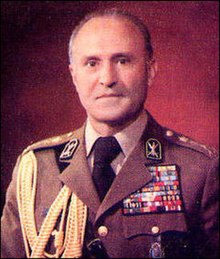
Summary
Arteshbod Abbas Gharabaghi (Persian: عباس قرهباغی; 1 November 1918 – 14 October 2000) was an Iranian general who was the last chief of staff of the Iranian Armed Forces as well as deputy commander-in-chief of the Iranian Imperial Army under the rule of Mohammad Reza Pahlavi, the last Shah of Iran. Gharabaghi was one of two senior military officials who were not detained and executed by the Islamic Revolutionary Council.[1]
Abbas Gharabaghi | |
|---|---|
 | |
| Minister of Interior | |
| In office 27 August 1978 – 4 January 1979 | |
| Monarch | Mohammad Reza Pahlavi |
| Prime Minister | Jafar Sharif-Emami Gholam-Reza Azhari |
| Preceded by | Asadollah Nasr Esfahani |
| Succeeded by | Shapour Bakhtiar |
| Member of Regency Council | |
| In office 13 January 1979 – 22 January 1979 | |
| Appointed by | Mohammad Reza Pahlavi |
| Personal details | |
| Born | Abbas Gharabaghi 1 November 1918 Tabriz, Sublime State of Persia |
| Died | 14 October 2000 (aged 81) Paris, France |
| Nationality | Iranian |
| Alma mater | Officers' School |
| Profession | Military Officer |
| Military service | |
| Allegiance | |
| Branch/service | Imperial Iranian Army |
| Years of service | 1938–1979 |
| Rank | |
| Unit | 22nd Infantry Regiment (Mounted) |
| Commands | Commander-in-Chiefs of the Iranian Armed Forces |

Background and career edit
Gharabaghi was of Azeri origin.[2] He served as the gendarmerie commander until 1979.[3] When intensive protests broke out in 1978, both Hassan Toufanian and Amir Hossein Rabii intended to carry out a coup to stabilize the turmoil in the country.[4] Their idea was not backed by other senior military officials, including General Abbas Gharabaghi.[4]
He was appointed chief of staff of the Iranian Armed Forces on 7 January 1979. His role was to support the Shah until the Shah left Iran, and then to support the civilian government the Shah left behind led by Prime Minister Shapour Bakhtiar. However, after much strife on the streets of Tehran and elsewhere, on 11 February 1979 Gharabaghi, along with 22 other senior military leaders, withdrew support of Bakhtiar, thus tacitly supporting the revolutionary Islamic Republic.[5][6]
In December 1979, the exiled Shah argued that the meeting in January 1978 between General Robert Huyser, who was deputy commander-in-chief of the U.S. forces in Europe, and Mehdi Bazargan, who would serve as the prime minister under Ayatollah Khomeini, was organized by Abbas Gharabaghi.[7] He further claimed that Gharabaghi was a traitor.[8]
Works edit
Gharabaghi published his account of the revolution in his books Haghayegh Darbareye Bohran-e Iran ("Facts About the Iran Crisis", 1983), and Che Shod Ke Chonan Shod? (translated as "Why did it happen?", 1999).[9] He argued that his decision to declare the army's "neutrality" was the main reason for the final triumph of the Islamic Revolution.
In his first book, Gharabaghi expresses his strong support for and loyalty to the Shah and paints a detailed picture of the chaos within the military ranks during the final days of the government, placing the blame on Prime Minister Bakhtiar for its collapse.[10] He justifies his decision to declare the army's "neutrality" as the only reasonable solution given the circumstances in order to prevent further bloodshed, calling Bakhtiar a traitor.
Death edit
Gharabaghi died in Paris in 2000. He was buried in Père Lachaise Cemetery.
References edit
- ^ John M. Smith (June 1980). Where was the Shah's Army? (PDF) (Master of Military Art and Science thesis). US Army Command and General Staff College. Archived (PDF) from the original on 4 August 2021.
- ^ Khosrow Fatemi (Winter 1982). "Leadership by Distrust: The Shah's Modus Operandi". Middle East Journal. 36 (1): 59. JSTOR 4326355.
- ^ Mark J. Roberts (January 1996). "Khomenei's incorporation of the Iranian military" (McNair Paper 48). National Defense University. Archived (PDF) from the original on 5 March 2016. Retrieved 31 July 2013.
- ^ a b Rebecca Cann; Constantine Danopoulos (Winter 1997). "The Military and Politics in a Theocratic State: Iran as Case Study". Armed Forces & Society. 24 (2): 274. doi:10.1177/0095327X9702400204. S2CID 145350433.
- ^ Bakhtiar Quits After Losing Army Backing The Guardian, 12 February 1979
- ^ Memory Lane: Looking Back At The Road To Revolution The Iranian, 11 February 2001
- ^ Leonard Downie Jr. (8 December 1979). "Shah Says U.S. Worked Actively for His Ouster". The Washington Post. Retrieved 5 August 2021.
- ^ Tariq M. Mir (30 November 2017). "A Diplomat's Diary". Hilal. 54 (5).
- ^ Che Shod Ke Chonan Shod? [Why did it happen?]. ISBN 0967019915.
- ^ Abbas Gharabaghi (1983). Haghayegh Dar Bareye Bohran-e Iran (in Persian). Paris: Sāzmān-i Chāp va Intishārāt-i Suhayl.
External links edit
- Media related to Abbas Gharabaghi at Wikimedia Commons


